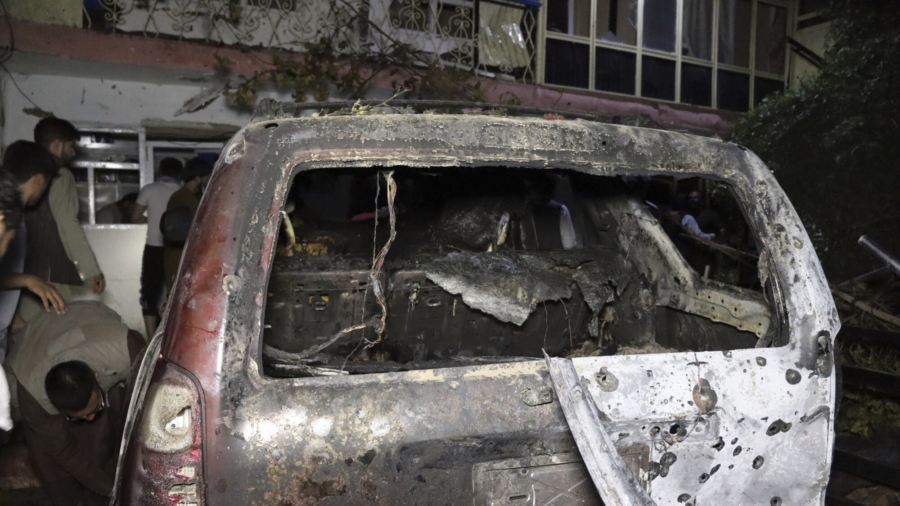The U.S. military is getting new guidance on how to avoid causing civilian casualties in wartime.
On Thursday, the Department of Defense published its “Instruction on Civilian Harm Mitigation and Response.” The 52-page document instructs various DOD component organizations to designate personnel to identify relevant practices to reduce civilian harm and provides further instructions on how to respond when U.S. military actions do result in civilian casualties.
“The release of the DoD Instruction continues the process of improving the department’s approach to mitigating and responding to civilian harm,” Pentagon Press Secretary Brig. Gen. Pat Ryder said at a Thursday press briefing.
The document specifically calls for DOD components to “enhance battlespace awareness of civilian population density, demographics, and dynamics, and of the locations and functions of civilian objects.” DOD components must then implement these details and other civilian harm mitigation and response (CHMR) practices when planning military operations, including participating in operations with ally and partner forces.
The document also lays out instructions for assessing potential harm to civilians following military operations, such as airstrikes and large-scale raids or assaults.
“Civilian harm assessments will be promptly initiated, thorough, and completed in a timely manner,” and “will indicate whether, based upon the information available at the time of the assessment and depending on the scope of the assessment, civilian casualties or damage to or destruction of civilian objects more likely than not resulted from U.S. military operations.”
In instances where U.S. military action is suspected of causing harm to civilians, those military components are instructed to acknowledge fault and extend condolences “as appropriate under the circumstances.” The document calls for expressions of condolences to broader communities when individual acknowledgments and condolences are deemed impractical. Acknowledgments of U.S. military wrongdoing and responses may take the form of written or spoken condolences, condolence payments, repairs to damaged structures, ordinance removal efforts, and medical care.
“Commanders are encouraged to respond rapidly to civilian harm when appropriate and practicable; however, responses may be made after time has passed,” the document reads.
Military components are also instructed to publish reports at least quarterly providing updates on reviews and assessments of incidents of civilian harm.
Civilians Killed in US Strikes in Recent Years
The CHMR guidance comes about as multiple U.S. military operations have incurred civilian casualties in recent years.
A November 2021 report by The New York Times revealed that as many as 70 civilian noncombatants were killed by a U.S. airstrike in March of 2019 as U.S. and coalition forces fought to seize the ISIS stronghold of Baghouz in eastern Syria. The New York Times report indicated military officials had not investigated the 2019 airstrike. The Pentagon ordered a fresh review of the incident that same month.
The DoD review of the March 2019 strike in Baghouz determined a U.S. Ground Force Commander (GFC) repeatedly received faulty confirmations that there were no civilians in the area. The DoD review concluded civilian deaths were not the result of deliberate act and that there were no violations of the rules of engagement or laws of war. On the other hand, the review did conclude that there were “numerous policy compliance deficiencies at multiple levels of command” causing delays in reporting these civilian casualties, contributing to the impression that the U.S. military was not being transparent or treating these civilian casualties seriously.
In the closing days of the withdrawal from Afghanistan, U.S. forces botched another airstrike. The U.S. Central Command (CENTCOM) had originally reported the strike had targeted an ISIS member who posed a threat to evacuation operations at Hamid Karzai International Airport in Kabul, but subsequent evaluations revealed the strike had actually killed 10 innocent Afghan civilians. A U.S. Air Force review eventually concluded the tragic incident was a mistake resulting from “confirmation bias and communication breakdowns,” and the DoD determined no military troops or officials would face disciplinary action for the incident.
On May 3 of this year, CENTCOM reported it had conducted a unilateral strike on a senior Al-Qaeda leader in northwest Syria, but did not identify the Al-Qaeda leader by name. That same day, civilians in the northwest Syrian town of Qorqanya said a local man named Lotfi Hassan Misto had been killed by an unidentified drone while he was leading a flock of sheep to graze.
CENTCOM spokesman Michael Lawhorn subsequently announced the U.S. military command was aware of reports of a civilian casualty following the May 3 strike, and were continuing to assess the incident. In June, CENTCOM announced the incident had become the subject of a formal investigation.


